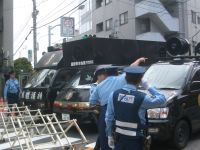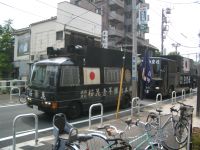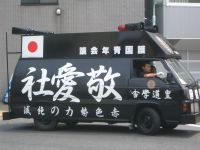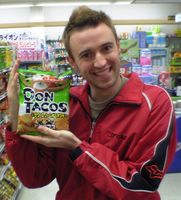Today I went to Asakusa temple in Tokyo to see the massive 3-day Asakusa Sanja Matsuri (festival).
Festivals in Japan are unlike any religious gathering I've ever seen in the states. I walked out of the subway station into a closed off street thronging with people. As you get closer to the main site of the festival, there's a mass of humanity that beckons you to come and watch as well. Wading through the crowd you start to notice little babies perched on their fathers' shoulders all decked out in the mainstay of traditional Japanese summer wear, the yukata (a bit looser and less fancy than kimonos), as well as crowds of people in happi coats and straw sandals. Walking farther in you may see a young man apparently clad only in a t-shirt over his sumo-style loincloth (or mawashi) and a scarf tied around his head with his mother holding the back of his t-shirt down so he isn't too indecent. Festivals are also one of the few places you can see Yakuza style full body tattoos, as they are verboten the rest of the year.
The reason for all this lack of clothing becomes clear as you approach the centerpiece of the Sanja Matsuri, the mikoshi. Mikoshi are portable shrines that are paraded around the neighborhood in order to bring blessing to the surrounding areas. The mikoshi can weigh up to a ton, and are carried on the shoulders of tens of men and women, often clad in nothing but traditional shirts and loincloths. The crowd packs around the carriers, vying for a closer look at the shrines, perhaps hoping that some blessings will be shaken off onto them. And shaken is the operative word, as the group surges backwards and forwards through the sea of humanity, bouncing the shrine up and down and tilting it side to side. Some other festivals are so vigorous that the shrines are smashed against each other in an attempt to destroy the neighboring temples' shrine. But this isn't one of those festivals, and the mikoshi merely sway through the crowd to the chants of the carriers and cheers of the onlookers.

Walking past the mikoshi and into the main temple you are greeted by an entirely different throng of people clambering to get up the temple steps to give offerings and prayers at the altar. When you enter any temple in Japan, there are several things you must do while you're there. The first is to wash your hands and mouth with water from the temple spring in order to purify yourself for entrance into the temple. The giant bronze incense burner at Asakusa is particularly famous for its powers to increase intelligence, so everyone brushes the smoke through their hair to partake of its power. Then people head up the main temple steps and try to make their way through the crowd up to the offering box. Failing that, many people will simply lob their coins over the heads of other worshipers and make their prayers from a distance.
Finally, and most important to some, is the requisite stop at the festival food and game tents. The summer in Japan is a non-stop season of festivals, and there are food vendors who travel around to each of the festivals. The tents include traditional Japanese favorites such as yakisoba (fried noodles) and okonomiyaki (vegetable pancakes), as well as area specialties such as steamed potatoes crispy fried and then split open and slathered with butter.
The games are mostly slight variations on carnival games we're all familiar with, such as catching goldfish to take home with you and watch perish through your negligence. The Japanese version has an interesting catch in that the scoop you are given to catch the fish with is made out of very thin paper stretched tight over a metal loop. It is almost impossible to catch fish with this implement, as the slightest movement of the catcher or catchee will tear the paper. There is a similar game with baby turtles, but the scoop is a thin crispy cookie cup, similar to a soft-serve ice cream cone.
In addition to the full suit tattoos carrying the mikoshi, there are definite underworld influences among the festival vendors, such as rows of curiously ordered burn marks on the forearm of one young man running the turtle fishing game. The underworld and the temple life seem to blend rather harmoniously, however, as the yakuza can be among the more traditional denizens of Japan. They may see themselves as carrying on the Samurai way, and generally keep their actions to themselves, rarely bothering the general public.
Japanese festivals permeate the life of modern Japan, from big city Tokyo to backwater burgs, but there is a sense that the spiritual aspects of the festivals have fallen out of favor with many Japanese. This probably has to do with the curious Japanese mixture of Buddhism, the native animist Shintoism, and Christianity. Many Japanese people will have a Western style wedding, a Shinto funeral, and visit Buddhist temples at festivals throughout the year. Given this pluralism, it's no surprise that each religions' influence is waning. The festivals also seem to maintain their popularity as a release from the strict codes of social conduct that most Japanese find they must adhere to. This certainly lends itself to the thriving, chanting, bouncing, teeming phenomenon that is matsuri.







